Walter Potter, the enigmatic figure of the 19th century, left the world bewildered with his stunning and whimsical displays of taxidermy art. Potter’s obsession with this craft took him to new heights, creating unconventional scenes that left audiences spellbound. From kittens enjoying high tea to rabbits playing cricket, Potter’s taxidermy exhibits redefined the very idea of the art form.
His methods were not just visually appealing but also full of humor, making him an instant crowd-pleaser. He often incorporated animals into human activities and accurately replicated Victorian clothing and lifestyles. Evidently, Potter’s ingenuity and attention to detail earned him the title of the “Taxidermy King.”
Potter’s most iconic piece was undoubtedly the “Death and Burial of Robin.” The diorama captured dozens of birds cradled in pallbearers, attending the funeral of a robin dressed in Victorian morning suits. This masterpiece became an instant sensation, earning Potter the popularity he craved.
In a world where death was a prominent theme, Potter’s lighthearted take on it was a refreshing delight. The diorama featured a notable sense of emotion, with the birds dressed in black, sipping tea, and spreading light green flowers on the grave’s soil. It was evident that Potter understood the power of exaggeration and knew how to tug at the audience’s heartstrings.
Potter’s art wasn’t just confined to the visual aspect but also conveyed a message of respect and love for nature. His dioramas portrayed animals as gentle, loving creatures who deserved our reverence, displaying them in life-like situations beyond taxidermy conventions.
The “Death and Burial of Robin” was more than just an artistic display but a reflection of Victorian ideals. Potter’s works visually depicted the underlying emotions of love, compassion, and loss. The message behind his dioramas was clearly palpable – an amalgamation of reverence, nostalgia, and sentiment.
In a world where the artists were replete with realism and seriousness, Potter’s surreal displays were a welcome change. It was as if he had transported his audience to a magical realm, filled with fairytales and childlike awe. His art provided us with a unique vantage point to view nature and its delicate beauty beyond the mortal boundary.
In conclusion, Walter Potter’s influence as an artist would forever remain etched in the annals of history, transcending the divide between norms and conventions. His art was a beautiful symphony, merging the bizarre and the whimsical into a masterful utterly captivating performance. Undoubtedly, Potter’s legacy would endure, inspiring a new generation of artists to break boundaries and push our senses beyond perceived norms.



